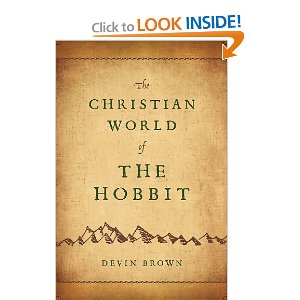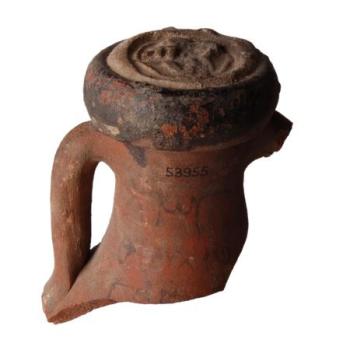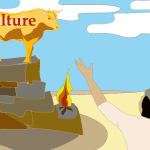The theme of providence is actually raised in the Hobbit (and its sequels) in an unusual way– it is called, ‘luck of an unusual kind'(and one might add, to an unusual degree). Bilbo was ‘meant’ to find the ring, and ‘meant’ to bring it back, and ‘meant’ to pass it on to Frodo, who in turn was ‘meant’ to take it to Mt. Mordor and dispose of it. The unseen hand has an invisible plan, but at the same time, Tolkien’s world is not a world of sheer pre-determination. To use Lewis’ terminology speaking of God “the Irresistible and the Indisputable are the two weapons which the very nature of his scheme forbids Him to use…He cannot ravish. He can only woo.” (quoted by Brown on p. 76). For Tolkien, as for Lewis and the other Inklings, “the idea of a world designed and guided by nothing more than blind chance and filled with rational beings who have no creator and no purpose, who simply live and then die without any meaning other than what they construct themselves,…[is] absurd.” (Brown p. 78). Equally for the Inklings, a world predetermined by a benevolent God is not the real world which is so filled with evil, darkness, disease, decay and death. The novels of Tolkien come to grips with the real tension between real Good and real Evil, and the power of real moral choice freely made by moral agents such as halflings and humans.
The Hobbits could fail in their mission, and there is no hint that somehow things would have still turned out alright. There are real moral choices for humans and halflings and others to make in the Hobbit, and they could have done otherwise. They have the power of contrary choice. They are not destined or fated to go one way or another, but all the same, there is a guiding hand, a purpose, a plan (see pp. 66-67). As Brown suggests, the way things work in Middle Earth, seem to comport with the way Tolkien saw God’s hand working in the real world (see pp. 59-60). It seems that the theme of Romans 8.28 was a guiding principle for Tolkien— ‘God works all things together for good, for those who love him’. The same cannot be said for those who hate him and serve the dark lord.
Brown is also quite right that there is a very strong emphasis on good vs. evil in these novels, and therefore on the importance of right as opposed to wrong moral choices. Indeed, as Brown shows at some length, it seems there is always a ‘right choice’ to be made when it comes to an ethical dilemma. Are their guides along the way for Bilbo and later Frodo? Yes, of course, there is Gandalf the wizard. Gandalf however is a messenger and a helper, not the savior. The Hobbits must be the ones who go on the quest and deal with the Ring. Gandalf has been sent by and serves some higher power, but he is not that power (see pp. 73-75), he calls himself a steward, perhaps even an ambassador of sorts. One could think of what Paul says of himself– an ambassador of Christ, steward of the mysteries of God. But Gandalf, like Paul, is not always there to save the day for his charges. They must persevere and prevail often without his help.
Tolkien of course strongly stresses the goodness of all created things and the notion that they are meant to be enjoyed. Thus the Hobbits model some of the very traits Tolkien himself most exhibited, who once called himself a hobbit— love of good food, good company, good discussion, appreciation of the beauty of simple things, ordinary life. “This right and good enjoyment of earthly pleasures becomes a problem only through excessive attachment to them.” (p.106). This analysis is not however entirely true. Tolkien would never have said a love of money was a good thing. It was not just greed, say of the dwarfs for gold, that was not a good thing. It was misdirected love, not mere excess that was the problem. The dwarfs represent all too well the modern materialistic world of the west where people love things and use people to get them, rather than loving people and using things.
When Tolkien was pressed on the goals of his fiction writing, he responded that his goal was “the elucidation of truth” and “the encouragement of good morals in the real world” and he claimed to accomplish this aim by means of “the ancient device of exemplifying them in unfamiliar embodiments” (quoted on p. 125). In other words, Tolkien’s fairy stories are in fact commentary on how he sees the real world, and how it is and also ought to be. They are not mere children’s tales. They are meant for adults as much as children, and they are not told as an end in themselves. They are not escapes from reality, but imaginative escapes into a moral reality which exists in the real world.
Brown aptly recognizes them, and highlights this fact in the latter part of his book. Notice as well that the characters in Tolkien’s fiction are flawed. Even at their best they are more like say David than Jesus, and sometimes more like Samson than Solomon. Even those on the dark side are not necessarily or always viewed as totally irredeemable. So there is a deliberate moral ambiguity to the characters in Middle Earth, they have potential for good or evil. Brown suggests that Tolkien’s fiction peels back the veil of the familiar to reveal the world as it actually is, and to make clear that life indeed is a morality play, and it matters enormously, even eternally, which side one is on.
Towards the close of the book, Brown puts his finger on a genuinely Gospel theme that pervades the Hobbit and the Lord of the Rings— that God chooses the weak, and the lowly, the least, the last, and the lost to accomplish his purposes and to shame the wise, the mighty, and the noble. Here the theme of 1 Cor. 1.26-27 comes to life in these novels, but of course it is also the theme Jesus himself announces in Luke 4– the conflict between good and evil paradoxically seems to be best fought by those the world would call meek and weak. Middle earth is saved by ordinary folk, not by Gandalf. Pages 159ff. are some of the clearest evidence Brown can present to justify a title like ‘The Christian World of the Hobbit’. Having said that, by citing a text like Zech. 4.6 it becomes clear that in fact this theme is not absent from the OT. It is simply front lighted and highlighted in the New Testament. Tolkien could not be accused however of triumphalism. There is real loss, real tragedy in these novels. There are deaths and funerals of good humans and halflings. Good only triumphs over and through tragedy, not by going around it.
A final quote from Brown is apt at this juncture: “The providence, purpose, and morality in the Hobbit go against the grain of the modern mind-set. In the Hibbit, Tolkien brings his readers into a world filled with meaning and purpose where they find stark contrasts between right and wrong. The same audience who might scoff at the Christian worldview in a different context find themselves embracing it in the Hobbit.” (p. 184). Just so, and so it could be said that the ‘euangellion’ in the end does come to light, for those who embrace not merely the stories of Tolkien, but the worldview that undergirds and guides the story.

















